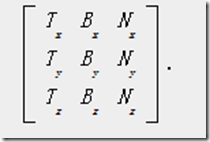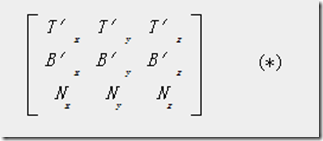原文地址:http://www.terathon.com/code/tangent.html
為一個任意網格模型計算其切線空間的基本向量(即切線空間的T B N三個向量)
Modern bump mapping (also known as normal mapping) requires that tangent plane basis vectors be calculated for each vertex in a mesh. This article presents the theory behind the computation of per-vertex tangent spaces for an arbitrary triangle mesh and provides source code that implements the proper mathematics.
現在的bump mapping(或者normal mapping)需要每個頂點的切面的基本向量。這篇文章描述了逐頂點計算任意三角模型的切線空間原理,并且提供了實現這個數學理論的源代碼。
Mathematical Derivation 數學來源
[This derivation also appears in Mathematics for 3D Game Programming and Computer Graphics, 2nd ed., Section 6.8.]
We want our tangent space to be aligned such that the x axis corresponds to the u direction in the bump map and the y axis corresponds to the v direction in the bump map. That is, if Q represents a point inside the triangle, we would like to be able to write
我們想我們的切線空間像這樣對齊,比如; X軸相當于bump圖中的U方向,而Y軸相當于bump圖中的V方向。于是,如果Q表示三角形上的一點,則我們可以得出如下等式
Q − P0 = (u − u0)T + (v − v0)B,
where T and B are tangent vectors aligned to the texture map, P0 is the position of one of the vertices of the triangle, and (u0, v0) are the texture coordinates at that vertex. The letter B stands for bitangent, but in many places it is stilled called binormal because of a mix-up in terms when tangent-space bump mapping first became widespread. (See “Bitangent versus Binormal” below.)
等式中的T是與紋理對應的切線向量,P0 是三角形的其中一個頂點。(u0, v0) 是對應頂點的紋理坐標。 B表示副(雙)切線(bitangent),但是由于在切線空間的bump mapping第一次被傳播開來的時候,有人混淆這個定義,所以在許多地方它始終被稱為副法線(binormal )。(參見下面的Bitangent VS Binormal)
Suppose that we have a triangle whose vertex positions are given by the points P0, P1, and P2, and whose corresponding texture coordinates are given by (u0, v0), (u1, v1), and (u2, v2). Our calculations can be made much simpler by working relative to the vertex P0, so we let
假設三角形的三個頂點分別為P0, P1, and P2, 其分別對應的紋理坐標為(u0, v0), (u1, v1), and (u2, v2). 。那我們的計算就可以簡化下為下面的方程式組
Q1 = P1 − P0
Q2 = P2 − P0
設
(s1, t1) = (u1 − u0, v1 − v0)
(s2, t2) = (u2 − u0, v2 − v0).
We need to solve the following equations for T and B.
于是,我們最終要解決的就是下面這個方程式
Q1 = s1T + t1B
Q2 = s2T + t2B
This is a linear system with six unknowns (three for each T and B) and six equations (the x, y, and z components of the two vector equations). We can write this in matrix form as follows.
這個有著6個未知數的線性方程組(T,B是向量,每個有三個量)。我們可以把它寫成如下的矩陣方式

Multiplying both sides by the inverse of the (s, t) matrix, we have
兩邊都乘以(s,t)的逆矩陣
 .
.
This gives us the (unnormalized) T and B tangent vectors for the triangle whose vertices are P0, P1, and P2. To find the tangent vectors for a single vertex, we average the tangents for all triangles sharing that vertex in a manner similar to the way in which vertex normals are commonly calculated. In the case that neighboring triangles have discontinuous texture mapping, vertices along the border are generally already duplicated since they have different mapping coordinates anyway. We do not average tangents from such triangles because the result would not accurately represent the orientation of the bump map for either triangle.
由此,我們解出等式后,就得到了未單位化的T和B。 為了找到單個頂點的切線向量,我們平均共享這個頂點的所有切三角形的的切線。法線也可以通過類似的方式計算出來。 而在這種情況下,相鄰的兩個三角形則會形成不連續的紋理映射,處于邊緣的頂點由于有不同的紋理坐標而經常被復制。我們沒有平均這些三角形的切線,因為我們的計算結果就可以不精確地描述每個三角形的切線朝向。
Once we have the normal vector N and the tangent vectors T and B for a vertex, we can transform from tangent space into object space using the matrix
一旦我們得到了一個頂點的法向量N和切線T和B。我們就可以用它們來構造一個由正切空間到對象空間的矩陣。

To transform in the opposite direction (from object space to tangent space—what we want to do to the light direction), we can simply use the inverse of this matrix. It is not necessarily true that the tangent vectors are perpendicular to each other or to the normal vector, so the inverse of this matrix is not generally equal to its transpose. It is safe to assume, however, that the three vectors will at least be close to orthogonal, so using the Gram-Schmidt algorithm to orthogonalize them should not cause any unacceptable distortions. Using this process, new (still unnormalized) tangent vectors T′ and B′ are given by
為了向反方向變換(從對象空間變換到正切空間,[法線貼圖時]我們需這樣處理光照方向),我們可以簡單地使用這個矩陣的逆矩陣。 但我們要注意切線向量并非總是與其它兩個向量,或法向量垂直的。于是,我們的逆矩陣并非總是等于其轉置矩陣。但是,可以安全地認為,這三個向量是非常接近正交關系的。 所以使用我們可以使用Gram-Schmidt算法來對其進行正交化,就不會出現不可接受的誤差了。
T′ = T − (N · T)N
B′ = B − (N · B)N − (T′ · B)T′/T′2
Normalizing these vectors and storing them as the tangent and bitangent for a vertex lets us use the matrixto transform the direction to light from object space into tangent space. Taking the dot product of the transformed light direction with a sample from the bump map then produces the correct Lambertian diffuse lighting value.
單位化這些向量并將其存為一個頂點的tangent 和bitangent 。
于是,我們可以用下面這個矩陣將光方向從對象空間轉換到切線空間。然后將轉換后的光照方向和bump圖中的采樣值點乘,然后再處理某些矯正因子就可以完成光照的計算。

It is not necessary to store an extra array containing the per-vertex bitangent since the cross product N × T′ can be used to obtain mB′, where m = ±1 represents the handedness of the tangent space. The handedness value must be stored per-vertex since the bitangent B′ obtained from N × T′ may point in the wrong direction. The value of m is equal to the determinant of the matrix in Equation (*). One may find it convenient to store the per-vertex tangent vector T′ as a four-dimensional entity whose w coordinate holds the value of m. Then the bitangent B′ can be computed using the formula
我們也不必要存儲bitangent這個值。因為N × T′可以得出我們的mB′,這里的m = ±1,表示切空間的左右手坐標系習慣。表示左右手坐標系習慣的這個值必須逐頂點存儲。因為bitangent B′ 是由N × T′計算得來,就可能指向錯誤的方向。m的值必須要和(*)中的決定保持一致。 所以我們可以用T′的w分量來存儲m值。最后B′的值就可以向下面一樣計算
B′ = T’w·(N × T′),
where the cross product ignores the w coordinate. This works nicely for vertex programs by avoiding the need to specify an additional array containing the per-vertex m values.
向量的叉乘忽略了w分量,因此不會造成任何影響。這樣就可以很好地寫頂點程序,而不用另外用空間來存儲m值。
Bitangent versus Binormal
The term binormal is commonly used as the name of the second tangent direction (that is perpendicular to the surface normal and u-aligned tangent direction). This is a misnomer. The term binormal pops up in the study of curves and completes what is known as a Frenet frame about a particular point on a curve. Curves have a single tangent direction and two orthogonal normal directions, hence the terms normal and binormal. When discussing a coordinate frame at a point on a surface, there is one normal direction and two tangent directions, which should be called the tangent and bitangent.
(上面講的就是binormal 和bitangent的區別)。
Source Code
The code below generates a four-component tangent T in which the handedness of the local coordinate system is stored as ±1 in the w-coordinate. The bitangent vector B is then given by B = (N × T) · Tw.
下面的代碼產生了一個4維的T,其第4個分量用于存儲左右手坐標系習慣。B 是由 B = (N × T) · Tw.計算而來。
 #include "Vector4D.h"
#include "Vector4D.h"


 struct Triangle
struct Triangle


 {
{
 unsigned short index[3];
unsigned short index[3];
 };
};


 void CalculateTangentArray(long vertexCount, const Point3D *vertex, const Vector3D *normal,
void CalculateTangentArray(long vertexCount, const Point3D *vertex, const Vector3D *normal,
 const Point2D *texcoord, long triangleCount, const Triangle *triangle, Vector4D *tangent)
const Point2D *texcoord, long triangleCount, const Triangle *triangle, Vector4D *tangent)


 {
{
 Vector3D *tan1 = new Vector3D[vertexCount * 2];
Vector3D *tan1 = new Vector3D[vertexCount * 2];
 Vector3D *tan2 = tan1 + vertexCount;
Vector3D *tan2 = tan1 + vertexCount;
 ZeroMemory(tan1, vertexCount * sizeof(Vector3D) * 2);
ZeroMemory(tan1, vertexCount * sizeof(Vector3D) * 2);

 for (long a = 0; a < triangleCount; a++)
for (long a = 0; a < triangleCount; a++)


 {
{
 long i1 = triangle->index[0];
long i1 = triangle->index[0];
 long i2 = triangle->index[1];
long i2 = triangle->index[1];
 long i3 = triangle->index[2];
long i3 = triangle->index[2];

 const Point3D& v1 = vertex[i1];
const Point3D& v1 = vertex[i1];
 const Point3D& v2 = vertex[i2];
const Point3D& v2 = vertex[i2];
 const Point3D& v3 = vertex[i3];
const Point3D& v3 = vertex[i3];

 const Point2D& w1 = texcoord[i1];
const Point2D& w1 = texcoord[i1];
 const Point2D& w2 = texcoord[i2];
const Point2D& w2 = texcoord[i2];
 const Point2D& w3 = texcoord[i3];
const Point2D& w3 = texcoord[i3];

 float x1 = v2.x - v1.x;
float x1 = v2.x - v1.x;
 float x2 = v3.x - v1.x;
float x2 = v3.x - v1.x;
 float y1 = v2.y - v1.y;
float y1 = v2.y - v1.y;
 float y2 = v3.y - v1.y;
float y2 = v3.y - v1.y;
 float z1 = v2.z - v1.z;
float z1 = v2.z - v1.z;
 float z2 = v3.z - v1.z;
float z2 = v3.z - v1.z;

 float s1 = w2.x - w1.x;
float s1 = w2.x - w1.x;
 float s2 = w3.x - w1.x;
float s2 = w3.x - w1.x;
 float t1 = w2.y - w1.y;
float t1 = w2.y - w1.y;
 float t2 = w3.y - w1.y;
float t2 = w3.y - w1.y;

 float r = 1.0F / (s1 * t2 - s2 * t1);
float r = 1.0F / (s1 * t2 - s2 * t1);
 Vector3D sdir((t2 * x1 - t1 * x2) * r, (t2 * y1 - t1 * y2) * r,
Vector3D sdir((t2 * x1 - t1 * x2) * r, (t2 * y1 - t1 * y2) * r,
 (t2 * z1 - t1 * z2) * r);
(t2 * z1 - t1 * z2) * r);
 Vector3D tdir((s1 * x2 - s2 * x1) * r, (s1 * y2 - s2 * y1) * r,
Vector3D tdir((s1 * x2 - s2 * x1) * r, (s1 * y2 - s2 * y1) * r,
 (s1 * z2 - s2 * z1) * r);
(s1 * z2 - s2 * z1) * r);

 tan1[i1] += sdir;
tan1[i1] += sdir;
 tan1[i2] += sdir;
tan1[i2] += sdir;
 tan1[i3] += sdir;
tan1[i3] += sdir;

 tan2[i1] += tdir;
tan2[i1] += tdir;
 tan2[i2] += tdir;
tan2[i2] += tdir;
 tan2[i3] += tdir;
tan2[i3] += tdir;

 triangle++;
triangle++;
 }
}

 for (long a = 0; a < vertexCount; a++)
for (long a = 0; a < vertexCount; a++)


 {
{
 const Vector3D& n = normal[a];
const Vector3D& n = normal[a];
 const Vector3D& t = tan1[a];
const Vector3D& t = tan1[a];

 // Gram-Schmidt orthogonalize
// Gram-Schmidt orthogonalize
 tangent[a] = (t - n * Dot(n, t)).Normalize();
tangent[a] = (t - n * Dot(n, t)).Normalize();

 // Calculate handedness
// Calculate handedness
 tangent[a].w = (Dot(Cross(n, t), tan2[a]) < 0.0F) ? -1.0F : 1.0F;
tangent[a].w = (Dot(Cross(n, t), tan2[a]) < 0.0F) ? -1.0F : 1.0F;
 }
}

 delete[] tan1;
delete[] tan1;
 }
}
How to cite this article
Lengyel, Eric. “Computing Tangent Space Basis Vectors for an Arbitrary Mesh”. Terathon Software 3D Graphics Library, 2001. http://www.terathon.com/code/tangent.html